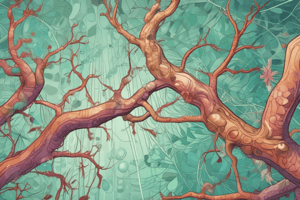Podcast
Questions and Answers
Which branch of biology is concerned with the study of plants?
Which branch of biology is concerned with the study of plants?
- Botany (correct)
- Zoology
- Ecology
- Microbiology
What is the primary function of mitochondria in a cell?
What is the primary function of mitochondria in a cell?
- Generating energy for the cell (correct)
- Cell division
- Storing genetic material
- Protein synthesis
What is the process by which cells generate energy from glucose?
What is the process by which cells generate energy from glucose?
- Mitosis
- Photosynthesis
- Protein synthesis
- Cellular respiration (correct)
What is the law that states that each pair of alleles separates during gamete formation?
What is the law that states that each pair of alleles separates during gamete formation?
What is the structure of DNA composed of?
What is the structure of DNA composed of?
What is the process of natural selection?
What is the process of natural selection?
What is the fossil record an evidence of?
What is the fossil record an evidence of?
What is the study of the interactions between organisms and their environment?
What is the study of the interactions between organisms and their environment?
Study Notes
Branches of Biology
- Botany: Study of plants, including their structure, growth, evolution, classification, and distribution.
- Zoology: Study of animals, including their structure, behavior, evolution, classification, and distribution.
- Microbiology: Study of microorganisms, including bacteria, viruses, and other microorganisms.
- ** Ecology**: Study of the interactions between organisms and their environment.
Cell Biology
- Cell Structure:
- Nucleus: contains genetic material (DNA)
- Mitochondria: generates energy for the cell
- Endoplasmic reticulum: involved in protein synthesis and transport
- Ribosomes: site of protein synthesis
- Cellular Processes:
- Photosynthesis: process by which plants convert light energy into chemical energy
- Cellular respiration: process by which cells generate energy from glucose
- Mitosis: process of cell division
Genetics
- Mendel's Laws:
- Law of Segregation: each pair of alleles separates during gamete formation
- Law of Independent Assortment: alleles for different genes are sorted independently
- Law of Dominance: one allele can be dominant over another
- DNA Structure:
- Double helix model: two complementary strands of nucleotides
- Nucleotides: composed of sugar, phosphate, and nitrogenous bases (A, C, G, T)
Evolution
- Mechanisms of Evolution:
- Natural Selection: process by which populations adapt to their environment
- Genetic Drift: random change in allele frequencies
- Gene Flow: movement of genes between populations
- Evidence for Evolution:
- Fossil Record: chronological record of ancient life forms
- Comparative Anatomy: similarities and differences in body structure
- Molecular Biology: similarities and differences in DNA and protein sequences
Branches of Biology
- Botany is the study of plants, including their structure, growth, evolution, classification, and distribution.
- Zoology is the study of animals, including their structure, behavior, evolution, classification, and distribution.
- Microbiology is the study of microorganisms, including bacteria, viruses, and other microorganisms.
- Ecology is the study of the interactions between organisms and their environment.
Cell Biology
- The nucleus contains genetic material (DNA) and is the control center of the cell.
- Mitochondria are the site of cellular respiration, generating energy for the cell.
- The endoplasmic reticulum is involved in protein synthesis and transport.
- Ribosomes are the site of protein synthesis.
- Photosynthesis is the process by which plants convert light energy into chemical energy.
- Cellular respiration is the process by which cells generate energy from glucose.
- Mitosis is the process of cell division.
Genetics
- Mendel's Law of Segregation states that each pair of alleles separates during gamete formation.
- Mendel's Law of Independent Assortment states that alleles for different genes are sorted independently.
- Mendel's Law of Dominance states that one allele can be dominant over another.
- DNA is structured as a double helix, composed of two complementary strands of nucleotides.
- Nucleotides are composed of sugar, phosphate, and nitrogenous bases (A, C, G, T).
Evolution
- Natural Selection is the process by which populations adapt to their environment.
- Genetic Drift is a random change in allele frequencies.
- Gene Flow is the movement of genes between populations.
- The Fossil Record provides a chronological record of ancient life forms.
- Comparative Anatomy reveals similarities and differences in body structure.
- Molecular Biology reveals similarities and differences in DNA and protein sequences.
Studying That Suits You
Use AI to generate personalized quizzes and flashcards to suit your learning preferences.
Description
Explore the different branches of biology, including botany, zoology, microbiology, and ecology, and learn about cell structure and its components.




